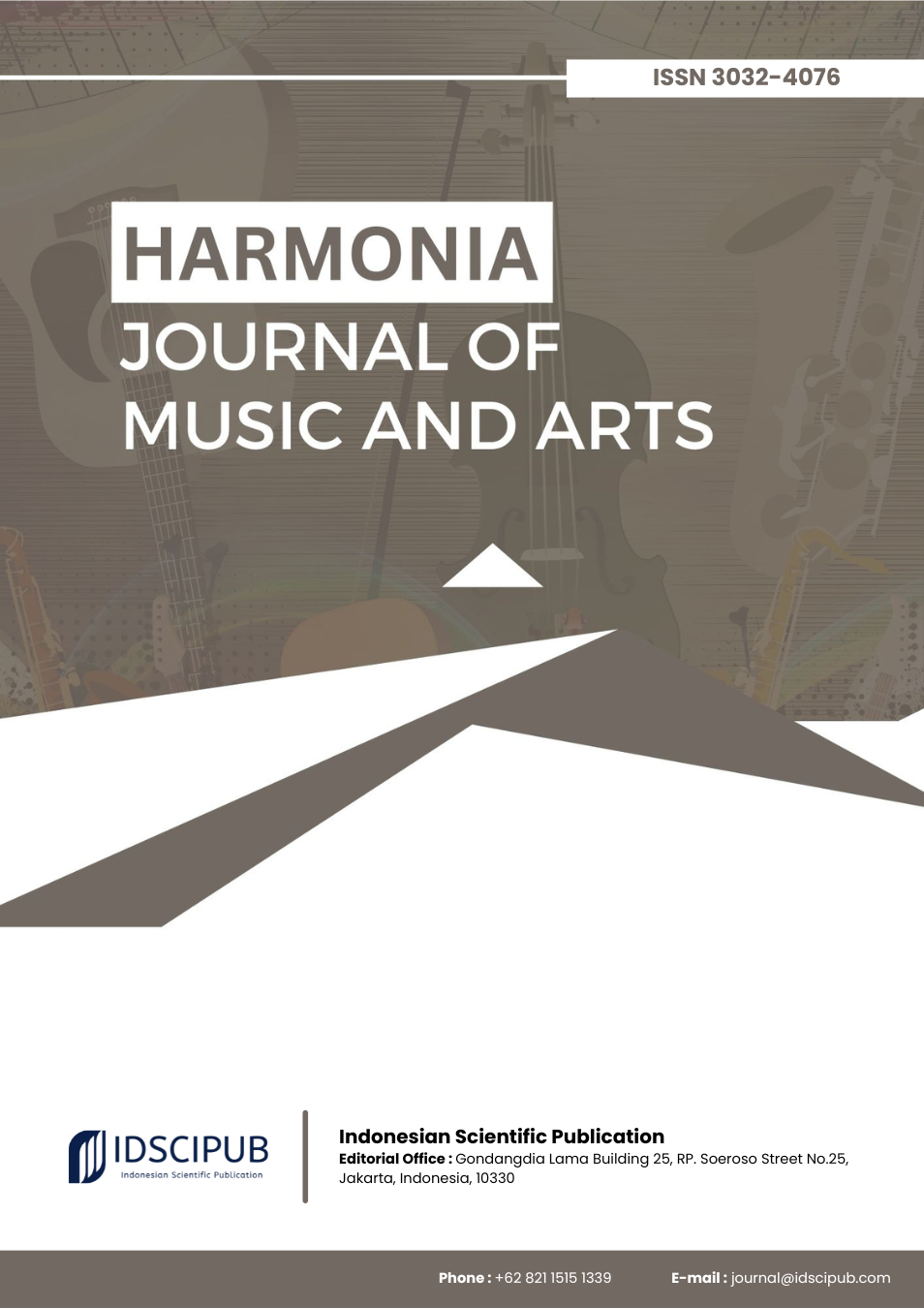Cultural Preservation and Innovation in the Era of Digital Visual Arts
DOI:
https://doi.org/10.61978/harmonia.v3i2.897Keywords:
Digital Transformation in Visual Arts, Artificial Intelligence and Creativity, Virtual Reality in Art, Augmented Reality and Audience Engagement, Digital Archives and Online Exhibitions, Authenticity and Copyright in Art, Cultural Preservation in Digital EraAbstract
Digital transformation is redefining the landscape of visual arts, merging technological innovation with evolving cultural and aesthetic practices. This narrative review examines the integration of artificial intelligence, virtual reality, and augmented reality into visual arts, focusing on opportunities, challenges, and aesthetic transformations. Literature was gathered from databases such as Scopus, Google Scholar, IEEE Xplore, and Web of Science using targeted keywords, with peer-reviewed studies published in the last decade included based on relevance to digital art practices. Results reveal that emerging technologies significantly enhance creativity, audience engagement, and accessibility through immersive experiences, digital archives, and online exhibitions. However, challenges persist, including risks of artistic identity loss, ethical dilemmas in authorship and intellectual property, and disparities in technological access across regions. Systemic factors, including policy frameworks, cultural institutions, and education, critically shape how these technologies are adopted and perceived. Proposed solutions highlight blockchain authentication, digital literacy initiatives, and policy interventions to balance innovation with cultural preservation. Nonetheless, research gaps remain, particularly in addressing socio-cultural implications and long-term effects of digital tools on creativity and heritage. This review underscores the urgency of interdisciplinary strategies and global collaboration to ensure digital transformation enriches, rather than diminishes, cultural diversity and artistic integrity.
References
Begum, M., Shorif, S., Uddin, M., Ferdush, J., Jan, T., Barros, A., … & Whaiduzzaman, M. (2024). Image watermarking using discrete wavelet transform and singular value decomposition for enhanced imperceptibility and robustness. Algorithms, 17(1), 32. https://doi.org/10.3390/a17010032 DOI: https://doi.org/10.3390/a17010032
Cai, C. (2024). Virtual reality enables the dissemination and preservation of early works of art. Applied Mathematics and Nonlinear Sciences, 9(1). https://doi.org/10.2478/amns-2024-0728 DOI: https://doi.org/10.2478/amns-2024-0728
Cheddad, A. (2020). On box-cox transformation for image normality and pattern classification. IEEE Access, 8, 154975–154983. https://doi.org/10.1109/access.2020.3018874 DOI: https://doi.org/10.1109/ACCESS.2020.3018874
Chen, C. (2024). Analysis of the application of 3D technology in digital media art animation design. Applied Mathematics and Nonlinear Sciences, 9(1). https://doi.org/10.2478/amns-2024-1244 DOI: https://doi.org/10.2478/amns-2024-1244
Chen, L. (2024). Research on key technologies and eco-innovation strategies for digital transformation of art industry. Applied Mathematics and Nonlinear Sciences, 9(1). https://doi.org/10.2478/amns-2024-2996 DOI: https://doi.org/10.2478/amns-2024-2996
Chesher, C., & Albarrán‐Torres, C. (2023). The emergence of autolography: The ‘magical’ invocation of images from text through AI. Media International Australia, 189(1), 57–73. https://doi.org/10.1177/1329878x231193252 DOI: https://doi.org/10.1177/1329878X231193252
Danacılar, İ. (2024). Digital transformation of art and design. pp. 105–134. https://doi.org/10.4018/979-8-3693-4318-0.ch006 DOI: https://doi.org/10.4018/979-8-3693-4318-0.ch006
Du, Y. (2023). Research on the transformation and innovation of visual art design form based on digital fusion technology. Applied Mathematics and Nonlinear Sciences, 9(1). https://doi.org/10.2478/amns.2023.2.00755 DOI: https://doi.org/10.2478/amns.2023.2.00755
Gao, Y. (2021). Artistic digital display and analysis of interactive media wireless sensor clusters. Journal of Sensors, 2021(1). https://doi.org/10.1155/2021/8098203 DOI: https://doi.org/10.1155/2021/8098203
Hernández-Cabronero, M., Sánchez, V., Blanes, I., Aulí-Llinàs, F., Marcellin, M., & Serra-Sagristà, J. (2019). Mosaic-based color-transform optimization for lossy and lossy-to-lossless compression of pathology whole-slide images. IEEE Transactions on Medical Imaging, 38(1), 21–32. https://doi.org/10.1109/tmi.2018.2852685 DOI: https://doi.org/10.1109/TMI.2018.2852685
Huber, A., Dinham, J., & Chalk, B. (2015). Responding to the call: Arts methodologies informing 21st century literacies. Literacy, 49(1), 45–54. https://doi.org/10.1111/lit.12054 DOI: https://doi.org/10.1111/lit.12054
Katsaridou, M., & Kostopoulou, L. (2024). Introduction: Animation as semiosis and as meaning. Punctum International Journal of Semiotics, 10(1), 5–12. https://doi.org/10.18680/hss.2024.0001 DOI: https://doi.org/10.18680/hss.2024.0001
Kim, D. (2025). A study on the spatial visual elements in extended reality content. Edelweiss Applied Science and Technology, 9(3), 1429–1438. https://doi.org/10.55214/25768484.v9i3.5554 DOI: https://doi.org/10.55214/25768484.v9i3.5554
Kotoula, E., Robinson, D., & Bedford, C. (2018). Interactive relighting, digital image enhancement and inclusive diagrammatic representations for the analysis of rock art superimposition: The main Pleito cave (CA, USA). Journal of Archaeological Science, 93, 26–41. https://doi.org/10.1016/j.jas.2018.02.012 DOI: https://doi.org/10.1016/j.jas.2018.02.012
Li, S. (2020). Visual form beyond traditional media—on the expression and construction of watercolor art in digital painting. E3S Web of Conferences, 189, 03013. https://doi.org/10.1051/e3sconf/202018903013 DOI: https://doi.org/10.1051/e3sconf/202018903013
Liu, B., Liu, H., & Dung, V. (2022). 3D animation graphic enhancing process effect simulation analysis. Wireless Communications and Mobile Computing, 2022, 1–11. https://doi.org/10.1155/2022/9208495 DOI: https://doi.org/10.1155/2022/9208495
Liu, Z. (2024). Exploring the application of computer visual arts in the context of digital media. Applied Mathematics and Nonlinear Sciences, 9(1). https://doi.org/10.2478/amns-2024-0492 DOI: https://doi.org/10.2478/amns-2024-0492
Mesquita, H., Baptista, A., & Silva, O. (2025). Delimiting the future in the relationship between AI and photographic pedagogy. Open Education Studies, 7(1). https://doi.org/10.1515/edu-2025-0065 DOI: https://doi.org/10.1515/edu-2025-0065
Oszust, M., Padjasek, J., & Kasprzyk, P. (2017). An approach to vision-based localisation with binary features for partially sighted people. Signal, Image and Video Processing, 11(7), 1261–1269. https://doi.org/10.1007/s11760-017-1083-x DOI: https://doi.org/10.1007/s11760-017-1083-x
Peláez‐Sánchez, I., Velarde-Camaqui, D., & Glasserman‐Morales, L. (2024). The impact of large language models on higher education: Exploring the connection between AI and Education 4.0. Frontiers in Education, 9. https://doi.org/10.3389/feduc.2024.1392091 DOI: https://doi.org/10.3389/feduc.2024.1392091
Sen, S., & Sen, I. (2024). Short digital storytelling. pp. 261–296. https://doi.org/10.4018/979-8-3373-1017-6.ch009 DOI: https://doi.org/10.4018/979-8-3373-1017-6.ch009
Sharma, A., & Singh, A. (2022). The expansion of new media art in Indian visual art practices: An analysis. ECS Transactions, 107(1), 10529–10541. https://doi.org/10.1149/10701.10529ecst DOI: https://doi.org/10.1149/10701.10529ecst
Vytkalov, S., Petrova, І., Гончарова, О., Herchanivska, P., & Kravchenko, A. (2024). Digital culture in the virtual space. Multidisciplinary Reviews, 7, 2024spe033. https://doi.org/10.31893/multirev.2024spe033 DOI: https://doi.org/10.31893/multirev.2024spe033
Wiratno, T., & Callula, B. (2024). Transformation of beauty in digital fine arts aesthetics: An artpreneur perspective. Aptisi Transactions on Technopreneurship (ATT), 6(2), 231–241. https://doi.org/10.34306/att.v6i2.395 DOI: https://doi.org/10.34306/att.v6i2.395
Yan-ping, L. (2025). Advancements in educational immersion and interaction through virtual reality technology. Journal of Computational Methods in Sciences and Engineering, 25(1), 685–698. https://doi.org/10.1177/14727978251322293 DOI: https://doi.org/10.1177/14727978251322293
Zeng, L., & Xiang, D. (2021). Artistic style conversion based on 5G virtual reality and virtual reality visual space. Mobile Information Systems, 2021, 1–8. https://doi.org/10.1155/2021/9312425 DOI: https://doi.org/10.1155/2021/9312425






